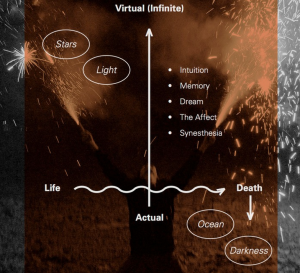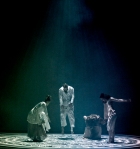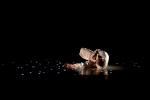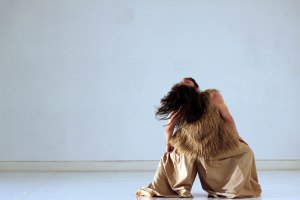the story of artist Sammy Chien and how he found the spiritual within, and then the technology, and rediscovered the spiritual
new promo for 2014
LEMI PONIFASIO / MAU – BIRDS WITH SKYMIRRORS
an amazing looking production, drawing on completely different themes to Beyond the Body, but ending up sharing some similar ground.
Lemi Ponifasio is a Samoan choreographer, currently based in New Zealand. this work focusses on oceanic pollution and climate change, and seems to unfold as a journey of spiritual beings through imagined landscapes.
its been touring for a few years. it has only visited the UK once – at Edinburgh Festival in 2010. i’d love to see it.
a review in Planet Magazine
the Spring issue of Planet – the Wales-based cultural-political magazine has a review of Beyond the Body, written by Charmian Savill, who came to see the show in Aberystwyth:
Circular and Mesmeric
A review of Beyond the Body
Charmian Savill
Taikabox Company presented their final performance of Beyond the Body on 28 November 2012 at Aberystwyth Arts Centre. This work involves five dancers, Eyebrow (‘a post jazz duo from Bristol’), a cinematographer and a digital artist.
With the company supported by five Cardiff-based institutions and recently working in Ebbw Vale, I anticipated some tough, ‘in-yer-face’ urban antics about industrial edgelands, poverty and dislocation. How wrong can you be? The opening moments revealed five very calm, still figures dressed in a mixture of loose soft shapes, Japanese design and sharp modern tailoring in natural colours and interesting textures. The design presented events and characters, which made me think of both the characters known as the ‘gardeners’ in Margaret Atwood’s novel The Year of the Flood, and of the futuristic sections of David Mitchell’s Cloud Atlas.
As they moved initially, floor light traced their circular, flowing gestures and rhythms, and their percussive breaths provided a surprising counterpoint. The smell of incense heightened the sense of a powerful ritual occasion for the dancers. I was unsure at this point how open the invitation might be, to join or share in this experience with them. They seemed to have found ritual dance which was personally empowering to them, and I was anxious that it might become self-regarding and have very little to do with the audience, as can happen with some autobiographical performance work.
However, the dancers then developed and changed this meditative phase by working with a back projection, which spilled onto the dance floor, revealing trees, their trunks and roots. Bill Mitchell’s succession of projected cinematographic images infiltrated and interacted with the bodies of the dance characters, who were identified by archetypal names such as Wanderer, Seeker, Shaman, Runner and Creator, and seemed engaged in some odyssey.
Constantly containing and shaping energy with compressive and circular movements, the dancers created fields of energy around themselves which became more extrovert and extravagant.
Kaleidoscopic and mutating projected images moved through bone shapes, starlit nights, a full moon, smoke, clouds and cityscapes, as reminders of worldly variety. My favourite sequence involved the image of white birds flying, slowed down to reveal detailed wing movements; this initially reminded me of a spinal column but it quickly morphed into what looked like thickening frost forming on a window. This was followed by some black smoky wraith-like shapes conjured by digital artist John Collingswood, which appeared projected onto the floor, springing responsively from the movements and rhythms of the dancers, and beginning to creep over the dancers’ bodies (reminding me of the ‘dementors’ that torment Harry Potter!).
My initial anxiety was overcome as I was drawn into the circular and mesmeric qualities of the gestures. Tanja Råman has evolved a surprising choreography which draws on Eastern structures of movement, derived from Tai Chi and in particular qigong; she also uses repetition, fluidity and non-predictable forms of contact. The dynamic use of yoga poses and the constant interplay of surface images, digital projections and sound engage the spectator in an unusual combination of scenography, dance and movement; and once the spectator has begun to recognise and enjoy the company’s starting points, Beyond the Body begins its dialogue.
Taikabox fuse the ancient and modern and use the poetics of both to create a futuristic place that feels playful, complicating and strong. Paul Wigens and Pete Judge played an impressive soundscape of electronically modified drums, violin and trumpet. The sound, image and light design created a symbiotic relationship with the movement, and the eye and ear were challenged to change focus continually.
I remain interested by the inference contained within the title: that we may want to go ‘beyond the body’. I enjoyed seeing dancers freely expressing their bodies and sharing their presence. Can you just be ‘with’ your body? Why are there so many ways devised to help us go beyond it? What importance does our culture place on dialogue, awareness and interaction with the body? Does the imagination, or a sense of the spiritual, take us outside the body; or are we located more deeply inside it? Does training for access to realms ‘beyond the body’ ultimately indicate a distrust concerning the role, place and potential of the body? So many attitudes towards the body are negative and are about ‘getting out of it’, or of ignoring its most basic needs in order to fulfil daily tasks and demands. Beyond the Body made me think a lot about how necessary it is to be ‘in the body’. The last sequence of the performance certainly focused on the possibilities and limits of the body, with a testing and vertiginous sequence of jumping performed on a continually changing, circular kaleidoscope of beautiful projected floor patterns. The dancers seemed to challenge themselves durationally in this section, which demonstrated their impressive training in breath control and physical precision, techniques with which to exhilarate and enliven both themselves and their audience. However, I’m still wondering about what it means to go ‘beyond the body’; and whether that is where I want to be.
the full performance
TaikaBox: Beyond the Body, Aberystwyth Arts Centre, November 28
Taika is a Finnish word for magic. So TaikaBox is a magic box, which is the nature of a theatre. In the evening’s program there is a quote from Pierre Teilhard de Chardin: ‘We are not human beings having a spiritual experience. We are spiritual beings having a human experience.’ In the context of Taikabox, that could describe an evening at the theatre. There is also a quote from Bruce Lee: ‘The intangible represents the real power of the universe – it is the seed of the tangible.’ If we substitute ‘theatre’ for ‘universe’, we arrive at the same proposition: what we see on stage (the tangible) is our human response to what is invisible (intangible), but we can only express this if we are spiritual beings to begin with.
This brings us to the starting point of choreographer Tania Råmon…
View original post 1,198 more words
tour photos
a selection of photos taken at the Riverfront by Michal Iwanowski. it’s been so difficult for me to document the use of projection within the project, its been great to get Michal and his camera in a dress rehearsal to grab these awesome images.
- fighting against gravity
- connected by energy
- a sea of stars
- above the forest
interviews with Tanja and John
the final performance
this Wednesday sees the last date on our first tour of Beyond the Body at Aberystwyth Arts Centre.
tickets for 28/11/12 at 7.30 are between £6 and £12 and can be booked by phoning 01790 623232 or clicking here.
its up to you: Newport, Newport

Beyond the Body at the Riverfront, Newport on Thursday 22nd November at 7.30
tickets can be booked here
I’m looking forward to this one – its going to look amazing on that big stage, and we’re filming a dress run on Thursday afternoon.





